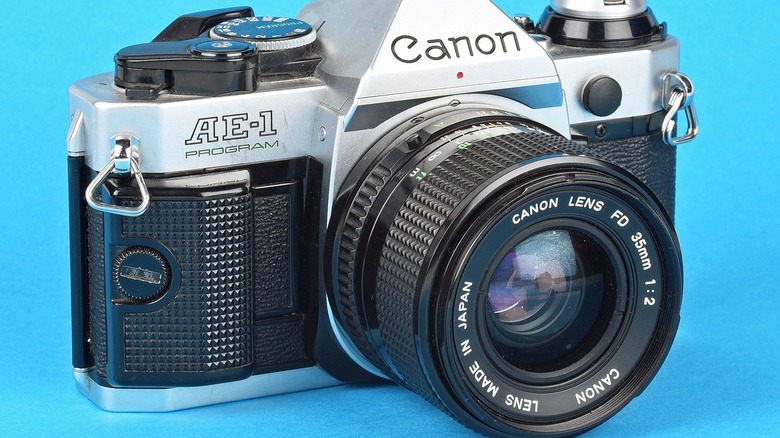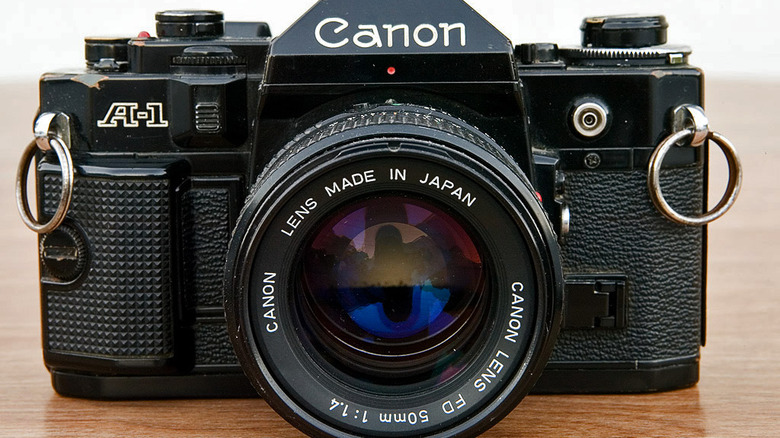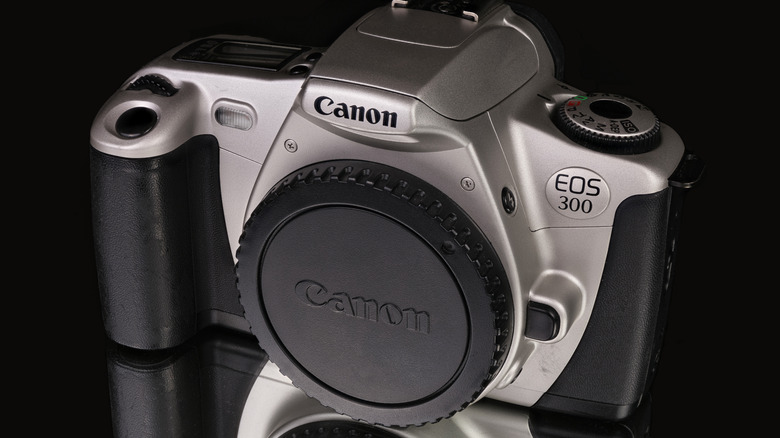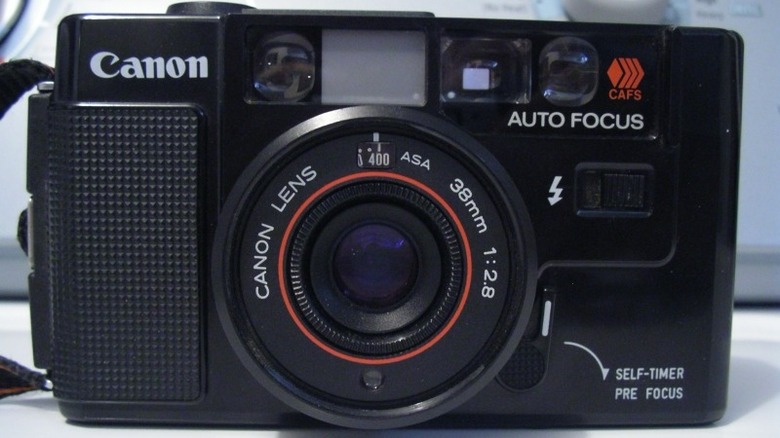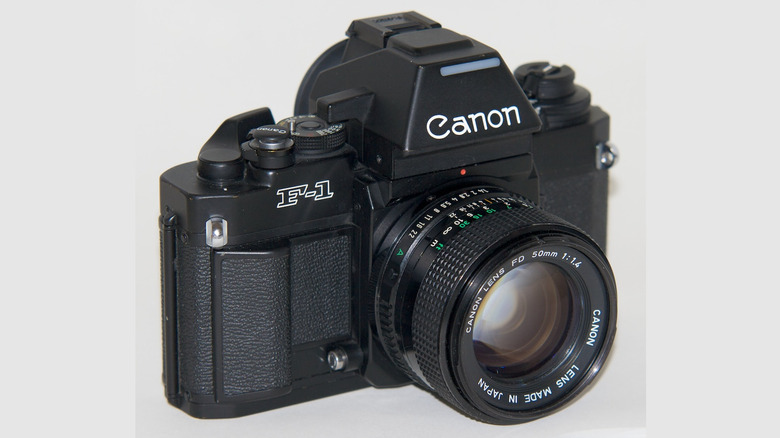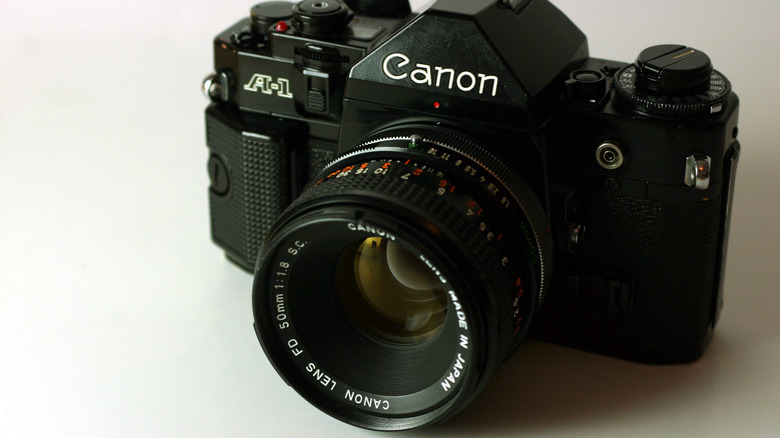The 4 Best Canon Film Cameras For Beginner Photographers
The love for analog has come back in a major way. You see this most explicitly with the explosion of sales in recent years of vinyl records, but there is also a distinct love for celluloid that is on the rise when it comes to photography and filmmaking. On the cinema side, movies like "Oppenheimer" have become an event in part because people needed to see it projected on 70-millimeter film in IMAX, just as it was shot. It's not just with movies, though. People are starving to get that look of true film in their photos, too. For a while, people were content with filters that could approximate this look for their Instagram photos, and the next step beyond that was the rise of instant Polaroid photos. Of course, people are coming to terms with the fact that the only way to get the look of the film is to shoot on 35-millimeter film.
The problem is that if you want a quality film camera nowadays from a company like Canon, which has long been a leader in this space, you will have to do quite a bit of digging. The company currently makes zero cameras for film photography, so if you want one, you are going to have to scour the used market, which can be daunting if you don't know where to start. Based on personal experience and recommendations from fellow photographers, here are four Canon film cameras that are great for starting your journey. There will be a more in-depth explanation as to why we chose these cameras at the end of the article.
[Featured image by Bertrand Labévue via Wikimedia Commons | Cropped and scaled | CC BY-SA 4.0]
Canon A-1
If this list was only going to feature one Canon film camera, that model would be the Canon A-1. The reason why this 35-millimeter SLR would be the one camera on this list isn't because it is the best Canon on the market — because it isn't — but it is one of the most accessible and easy-to-use models that the company has ever made.
Its popularity boils down to two major factors. The first is that the camera is built with Canon's FD lens mount. Throughout the 1970s and most of the '80s, Canon made a truly staggering amount of lenses that worked with an FD mount, giving you a ton of versatility for your photos. Whether you are looking for wide-angle, telephoto, fisheye, or zoom lenses, there are so many to choose from for each. The other reason the A-1 is so desirable is because of the built-in LED light meter in the viewfinder. You don't need to purchase anything additional to get accurate readings on your exposure settings.
Canon A-1 cameras can be as cheap as $50. However, if you want one in quality condition with a good lens, you are looking more at something in the range of $150 to $250, a perfectly reasonable price for the perfect starter camera. Canon has other pretty good A-body cameras, like the AE-1, AE-1 Program, and AV-1, but the A-1 is the standard-bearer.
[Featured image by pointnshoot via Wikimedia Commons | Cropped and scaled | CC BY 2.0]
Canon EOS Rebel 2000
If the previous Canon camera seems a bit too old for you, there are more modern options you can find that will satisfy any beginner photographer, and there may not be a better one to do that than the Canon EOS Rebel 2000, which hit the market in 1999. Also called the EOS 300 or the EOS Kiss III, depending on where in the world you are, the goal of the Rebel 2000 when it was created was to make photography easy for the average person. Therefore, much of what makes the camera appealing is its automatic features for exposure and focus. However, if you want to do your own metering, it has a robust 35-zone system to give you quite a bit of direction in capturing the best photos.
Another reason this makes for a great camera is that it has an EF lens mount, so if you already have a modern Canon EOS DSLR camera, all the lenses you can use for that are compatible with this camera as well. For cost-cutting purposes alone, that is a major benefit, as lenses can get pricier than buying the camera itself. It is a camera made entirely out of plastic and doesn't even weigh 12 ounces, so it may not be the most durable piece of equipment. However, for easy picture-taking, it's a terrific option. Plus, you can get them for very good prices, often being listed under $100, and it's not all that uncommon to find them for under $50.
[Featured image by Ansgar Koreng via Wikimedia Commons | Cropped and scaled | CC BY-SA 4.0]
Canon AF35M
With all of the cameras mentioned thus far, some degree of manual manipulation is required to get a proper, good-looking image. For many people looking to get into photography, they will learn to cherish these manual features and use them as a stepping stone to better and more advanced cameras that allow them to truly tailor their images to be exactly how they imagine them. However, not everybody who wants a film camera requires that. Some folks just want to be able to point the camera at something, take the photo, and move on with their day, simply wanting the film look. Well, Canon has an option for these people as well with the Canon AF35M Autoboy, or the Sure Shot as it was known in the United States.
This is a camera that comes with autofocus and an automatic flash that you can turn on and off. Instead of interchangeable lenses, you instead get a fixed 38-millimeter lens that's maxed out with an f/2.8 aperture. Basically, all you have to do is set the ASA to match the 35-millimeter film you load into the camera, and you can start snapping pictures. Relying on automation all the time can mean that some of your pictures don't come out the way you want them to, but expediency can make up the difference. It is not difficult to find a Canon AF35M for around $75.
[Featured image by Kingkong21 via Wikimedia Commons | Cropped and scaled | CC BY 2.5]
Canon New F-1
Being a beginner does not necessarily mean that you absolutely have to start off with beginner equipment. Sometimes, the best way to learn about a craft is to jump into the deep end and just get the top-shelf gear. The Canon New F-1 can act as a higher-level teaching tool than everything else on this list so far. By looking at it, you'll see it bears a striking resemblance to the aforementioned Canon A-1, but just about everything about the New F-1 is built with a higher quality, including limiting the amount of plastic used, for a heftier, more solid user experience.
This is also a camera entirely focused on manual operation. If you want things like Aperture Priority, Shutter Priority, or Autofocus, you need to either purchase additional attachments for the camera or just look elsewhere. The New F-1 features an FD lens mount, so all of those great Canon lenses used for those A-body cameras can be used here, too. In terms of light metering, it has a similar internal meter to those cameras but is even more precise, and it also comes with interchangeable focusing screens.
A better quality camera does mean a higher price. A quality used model can run you anywhere from $300 to $400. That may seem like a lot, but if you know for sure that film photography is your calling, why not start on a high note?
[Featured image by Ing. Richard Hilber via Wikimedia Commons | Cropped and scaled | Public Domain]
Why these Canon film cameras were chosen
Canon has made so many different 35-millimeter film cameras over the years that narrowing this list down to just four was extremely challenging, and it could not just be done solely on the opinion of one person. While I have personal experience with several of the cameras on this list, the opinions of others needed to be taken into account by photographers and critics around the internet to form some semblance of a consensus. This includes collating the takes from publications like Camera Legend, Digital Camera World, Dan Finnen, Mike Eckman, Gregory Couch, Casual Photophile, Lomography, DP Review, and more.
After those who were taken into consideration, the actual specs and features of each Canon camera were taken into consideration for their ability to be used by photography beginners. This is why medium and large format cameras were not included on the list, as it is best to work your way up to them. Lastly, a range in prices needed to be made available, as not every person looking to get into photography is on the same budget. However, because this is for beginners, no camera should pass an average price of $500. Of course, my personal experience with cameras like the A-1, AE-1 Program, and New F-1 were also taken into consideration. With all of this information to sift through, these four were the models that ultimately made the list.
[Featured image by RRT877 via Wikimedia Commons | Cropped and scaled | CC0 1.0]
